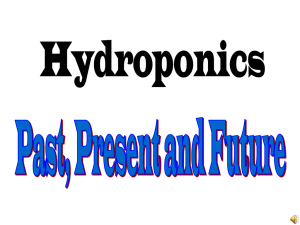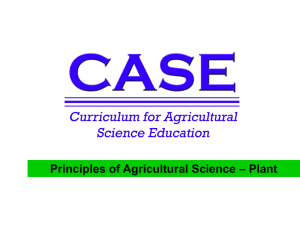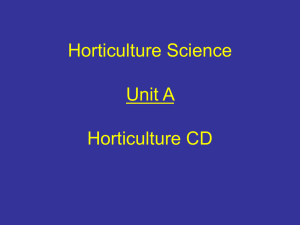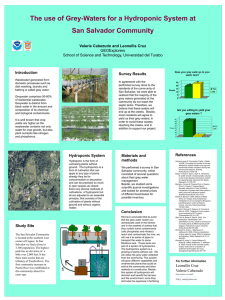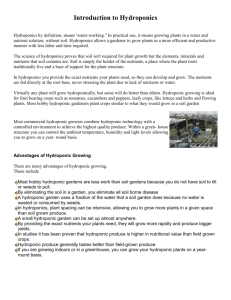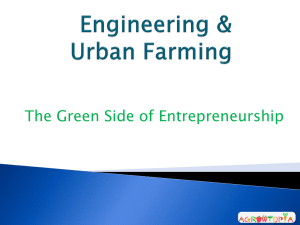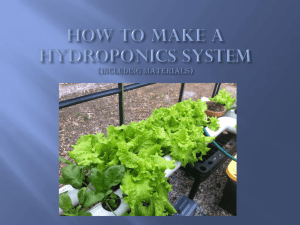Teacher`s Guide - American Chemical Society
advertisement
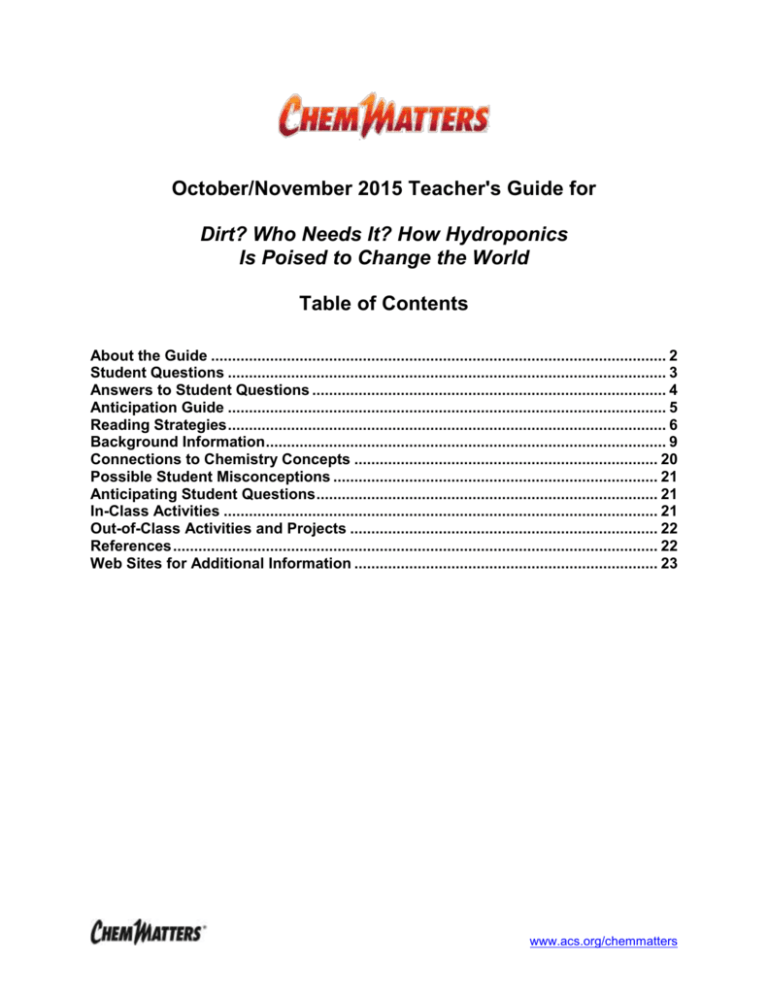
October/November 2015 Teacher's Guide for Dirt? Who Needs It? How Hydroponics Is Poised to Change the World Table of Contents About the Guide ............................................................................................................ 2 Student Questions ........................................................................................................ 3 Answers to Student Questions .................................................................................... 4 Anticipation Guide ........................................................................................................ 5 Reading Strategies ........................................................................................................ 6 Background Information ............................................................................................... 9 Connections to Chemistry Concepts ........................................................................ 20 Possible Student Misconceptions ............................................................................. 21 Anticipating Student Questions ................................................................................. 21 In-Class Activities ....................................................................................................... 21 Out-of-Class Activities and Projects ......................................................................... 22 References ................................................................................................................... 22 Web Sites for Additional Information ........................................................................ 23 www.acs.org/chemmatters About the Guide Teacher’s Guide editors William Bleam, Regis Goode, Donald McKinney, Barbara Sitzman and Ronald Tempest created the Teacher’s Guide article material. E-mail: bbleam@verizon.net Susan Cooper prepared the anticipation and reading guides. Patrice Pages, ChemMatters editor, coordinated production and prepared the Teacher’s Guide. E-mail: chemmatters@acs.org Articles from past issues of ChemMatters can be accessed from a DVD that is available from the American Chemical Society for $42. The DVD contains the entire 30-year publication of ChemMatters issues, from February 1983 to April 2013. The ChemMatters DVD also includes Article, Title and Keyword Indexes that covers all issues from February 1983 to April 2013. The ChemMatters DVD can be purchased by calling 1-800-227-5558. Purchase information can be found online at www.acs.org/chemmatters. 2 www.acs.org/chemmatters Student Questions 1. What is the predicted population of the world in 2030? Why is this important? 2. What is hydroponics? 3. What is the per cent composition of most plants? 4. What is the source of nutrients for plants that are grown hydroponically? 5. Name the two main chemicals needed for plant growth. 6. Who first introduced the term “hydroponics”? 7. What is the difference between macronutrients and micronutrients? 8. Name three plant macronutrients. 9. What solution condition is crucial for adequate delivery of nutrients to plants? 10. List two drawbacks to growing hydroponic plants, and one way these can be minimized. 3 www.acs.org/chemmatters Answers to Student Questions 1. What is the predicted population of the world in 2030? Why is this important? The article says the predicted world population in 2030 is 8–9 billion. The reason this is important, according to the article, is that the land available for agriculture may not be sufficient in 2030 to adequately feed that population. 2. What is hydroponics? “Hydroponics is the agricultural technique of growing plants in water instead of soil.” 3. What is the per cent composition of most plants? The article says that most plants are made up of “72% water, 24% organic material and 4% inorganic material, such as nitrogen and phosphorus.” 4. What is the source of nutrients for plants that are grown hydroponically? The nutrient source for hydroponic plants is a water solution containing the chemical nutrients (ions) that plants require for growth. 5. Name the two main chemicals needed for plant growth. Carbon dioxide and water are the essential chemicals for plant growth. 6. Who first introduced the term “hydroponics”? William Gericke, a scientist working at the University of California, Berkeley in the 1930s first coined the term. 7. What is the difference between macronutrients and micronutrients? According to the article, macronutrients are those chemicals that plants need in large amounts, while micronutrients are needed in smaller amounts. 8. Name three plant macronutrients. Potassium, nitrogen, phosphorus, and calcium are the plant macronutrients listed in the article. 9. What solution condition is crucial for adequate delivery of nutrients to plants? The pH of the solution is the condition important for nutrient delivery. 10. List two drawbacks to growing hydroponic plants, and one way these can be minimized. Growing plants hydroponically requires a light-controlled environment and water must flow constantly through the system, both of which are energy-intensive. One way to minimize this impact is to use solar panels (possibly as both the source of light and of energy to pump the water). 4 www.acs.org/chemmatters Anticipation Guide Anticipation guides help engage students by activating prior knowledge and stimulating student interest before reading. If class time permits, discuss students’ responses to each statement before reading each article. As they read, students should look for evidence supporting or refuting their initial responses. Directions: Before reading, in the first column, write “A” or “D,” indicating your agreement or disagreement with each statement. As you read, compare your opinions with information from the article. In the space under each statement, cite information from the article that supports or refutes your original ideas. Me Text Statement 1. Hydroponics is the fast growing field in agriculture. 2. People have been growing plants without soil for about a hundred years. 3. The solutes in a hydroponic solution include nutrients such as copper, calcium, and potassium. 4. Plants require only sunlight and water to grow. 5. The nutrients plants need in small amounts are called micronutrients. 6. The pH of a hydroponic solution should be slightly basic. 7. Ions that have precipitated out of solution are unavailable cannot be taken up by plant roots. 8. Most people can easily taste the difference between hydroponically grown tomatoes and those grown in soil. 9. The term “hydroponics” was coined by Walt Disney for the hydroponic garden at Disney World’s Epcot Them Park. 10. Hydroponic farms require a lot of energy to maintain. 5 www.acs.org/chemmatters Reading Strategies These graphic organizers are provided to help students locate and analyze information from the articles. Students’ understanding will be enhanced when they explore and evaluate the information themselves, with input from the teacher if students are struggling. Encourage students to use their own words and avoid copying entire sentences from the articles. The use of bullets helps them do this. If you use these reading strategies to evaluate student performance, you may want to develop a grading rubric such as the one below. Score Description 4 Excellent 3 Good 2 Fair 1 Poor 0 Not acceptable Evidence Complete; details provided; demonstrates deep understanding. Complete; few details provided; demonstrates some understanding. Incomplete; few details provided; some misconceptions evident. Very incomplete; no details provided; many misconceptions evident. So incomplete that no judgment can be made about student understanding Teaching Strategies: 1. Links to Common Core Standards for Reading: 1.9 ELA-Literacy.RST.9-10.5: Analyze the structure of the relationships among concepts in a text, including relationships among key terms (e.g., force, friction, reaction force, energy). 1.10 ELA-Literacy.RST.11-12.4: Determine the meaning of symbols, key terms, and other domain-specific words and phrases as they are used in a specific scientific or technical context relevant to grades 11-12 texts and topics. 2. Links to Common Core Standards for Writing: 2.9 ELA-Literacy.WHST.9-10.2F: Provide a concluding statement or section that follows from and supports the information or explanation presented (e.g., articulating implications or the significance of the topic). 2.10 ELA-Literacy.WHST.11-12.1E: Provide a concluding statement or section that follows from or supports the argument presented. 3. Vocabulary and concepts that are reinforced in this issue: 3.9 Solution chemistry 3.10 Chemical equilibrium 3.11 Acids and bases 3.12 pH 6 www.acs.org/chemmatters 3.13 3.14 Buffers Molecular structures 4. The infographic about autumn leaves on page 19 will engage students with more information about some of the natural dyes found in “Eating With Your Eyes.” 5. To help students engage with the text, ask students which article engaged them most and why, or what questions they still have about the articles. The Background Information in the ChemMatters Teachers Guide has suggestions for further research and activities. 7 www.acs.org/chemmatters Directions: As you read the article, complete the graphic organizer below to describe what you learned about hydroponics. 3 New things you learned 2 Ways an understanding of chemistry helps farmers grow plants hydroponically 1 Question you have about hydroponics Contact! What would you like to tell others about hydroponics? 8 www.acs.org/chemmatters Background Information (teacher information) More on agricultural land and water use The development of hydroponic and aquaponic agriculture today is a function of a decreasing supply of arable land and a parallel decrease in water available for irrigation. In the U.S., for example, about twenty per cent of the land is used for growing crops. However, according to the U.S. Environmental Protection Agency: In spite of a growing population and increased demand for agricultural products, the land area under cultivation in this country has not increased. While advanced farming techniques, including irrigation and genetic manipulation of crops, has permitted an expansion of crop production in some areas of the country, there has been a decrease in other areas. In fact, some 3,000 acres of productive farmland are lost to development each day in this country. There was an 8% decline in the number of acres in farms over the last twenty years. In 1990, there were almost 987 million acres in farms in the U.S., that number was reduced to just under 943 million acres by 2000, and then reduced to 914 million acres in 2012 (*1). Development pressure on farmland at the rural-urban interface is posing longterm challenges for production agriculture and for the country as a whole. This is especially significant since about two-thirds of the total value of U.S. agricultural production takes place in, or adjacent to, metropolitan counties (NRCS). About 1/3 of all U.S. farms are actually within metropolitan areas, representing 18% of the total farmland in this country (1992 – 1997 NRCS Report) (*3). http://www.epa.gov/agriculture/ag101/landuse.html In order to produce ever-increasing amounts of food for the growing population, farmers have had to resort to the use of pesticides and herbicides, artificial fertilizers and geneticallymodified crops. The first two have had negative consequences for the environment and GMOs remain controversial. In 2014, the U.S. Department of Agriculture (USDA) reported that: Pesticides—including herbicides, insecticides, and fungicides—have contributed to substantial increases in crop yields over the past five decades. Properly applied, pesticides contribute to higher yields and improved product quality by controlling weeds, insects, nematodes, and plant pathogens. In addition, herbicides reduce the amount of labor, machinery, and fuel used for mechanical weed control. However, because pesticides may possess toxic properties, their use often prompts concern about human health and environmental consequences. The examination of pesticide use trends is critical for informed pesticide policy debate and science-based decisions. (http://www.ers.usda.gov/media/1424195/eib124_summary.pdf) Similar USDA reports indicate that fertilizer use began its steady increase in the 1960s, and reached nearly 25 million tons by 1980. The graph below shows overall usage in addition to tracking potash (potassium), nitrogen and phosphate consumption individually. 9 www.acs.org/chemmatters (http://www.ers.usda.gov/topics/farm-practices-management/chemical-inputs/fertilizer-usemarkets.aspx) These kinds of data lead us to search for a method of farming that is not dependent on land use. Similarly, water use for farm irrigation is another important factor in the increase in hydroponics. Agriculture is a major user of ground and surface water in the United States, accounting for approximately 80 percent of the nation's water use and over 90 percent in many western states. The chart below shows the major uses of water in the United States with water for irrigation second only to its use in electric power plants. (http://water.usgs.gov/watuse/wuto.html) According to the United States Geologic Survey: For 2010, total irrigation withdrawals were 115,000 Mgal/d, which accounted for 38 percent of total freshwater withdrawals. Withdrawals from surface-water sources were 10 www.acs.org/chemmatters 65,900 Mgal/d, which accounted for 57 percent of the total irrigation withdrawals. Groundwater withdrawals for 2010 were 49,500 Mgal/d. About 62,400 thousand acres were irrigated in 2010, 31,600 thousand acres (51 percent) with sprinkler systems, 26,200 thousand acres with surface (flood), and 4,610 thousand acres with micro-irrigation systems. The national average application rate for 2010 was 2.07 acre-feet per acre. The map below shows the pattern of water use in the United States, by state. Note the highest use is in California which is currently experiencing a four-year drought. (http://water.usgs.gov/watuse/wuto.html) This map shows the current drought conditions in the United States. Western states, many of which are agricultural states, are most severely affected. 11 www.acs.org/chemmatters (http://droughtmonitor.unl.edu/) In summary, then, as the number of acres of agricultural land decreases and drought conditions are observed in more and more parts of the world, hydroponic growing becomes an attractive alternative to traditional agriculture. More on how plants grow The article indicates that soil is not necessary for plant growth. What, then, do plants need and how do they grow? If students understand the growth process for plants, then they will be able to better understand hydroponic farming. Plants need air, light, warmth, water and nutrients to be healthy along with certain inorganic nutrients. These are generally classified as macronutrients and micronutrients. Green plants grow by means of three processes—photosynthesis, respiration and transpiration. Photosynthesis accumulates the sun’s energy in the bonds of molecules like sugars and starches, and respiration uses that energy in order for plants to function. The basic chemistry of both processes should be well known to your students, but to review, the basic photosynthesis equation is: 6 CO2 + 6 H2O + energy C6H12O6 + 6O2 12 www.acs.org/chemmatters The chemical requirements for photosynthesis, then, are carbon dioxide and water along with energy in the form of light. The process takes place in the chloroplasts of plants. The chemical involved is chlorophyll, the pigment that makes plants green. The molecule takes several forms but the predominant form is chlorophyll a, which absorbs light primarily in the redorange range and the blue range of visible light (chlorophyll a reflects light in the green range, thus accounting for the green color of plants). The complementary form is chlorophyll b, which absorbs light that chlorophyll a cannot. The diagram at right shows the absorption pattern for each form. The photons of light excite electrons in the molecule that trigger a complex process that results in sugars and oxygen. (http://www.webexhibits.org /causesofcolor/7A.html) The structure of the chlorophyll a molecule appears at the left. The large ringlike structure, left side of the diagram, is a chelate with magnesium at the center of a four nitrogen atoms arranged in a squareplanar structure. This entire large ring structure is referred to as a porphyrin. The long hydrocarbon side chain is connected to the ring component by an ester bond, at lower left in the diagram. (http://brsmblog.com/woodward-wednesday-3chlorophyll-a/) The second process involved in plant growth is respiration. In this process the glucose produced by photosynthesis is oxidized to produce carbon dioxide, water and energy. The equation should look familiar: C6H12O6 + 6O2 6 CO2 + 6 H2O + energy This is the reverse of the photosynthesis equation. Oxygen is taken into the plant via the stomata and the roots. Carbon dioxide is expelled via the stomata and water not needed by the plant is eliminated via transpiration, the third process in overall plant growth. In plants the rate of photosynthesis is greater than the rate of respiration resulting in a net gain in plant biomass. Respiration occurs in all plant cells, not just in chloroplasts. Transpiration is the process by which plants lose water. About 90% of the water that enters a plant is lost by transpiration. Only 10% is used in chemical reactions and in the transport of minerals through the plant tissue. So, we find that the chemical requirements for plant growth are oxygen, carbon dioxide, water and mineral nutrients. Is soil necessary for plant growth? In conventional agriculture, soil supplies a set of mineral nutrients, as described in the article. The three main mineral nutrients, known as primary nutrients are potassium (K), nitrogen (N) and phosphorus (P). Plants use these three in large quantities (macronutrients), which is why these mineral elements are principal components of fertilizer. 13 www.acs.org/chemmatters These and all other mineral nutrients must be present in the soil in water-soluble form in order to be of use to plants. So the mineral nutrients in the soil are ions present in water-soluble compounds. Phosphorus is usually found in soil in the form of the phosphates H2PO4 – and HPO4–2. The phosphorus originally comes from the weathering of the parent material, which releases phosphate ions into the soil solution. This phosphate is adsorbed onto soil constituents, forming "reservoirs" of various types and capacities, some of which release phosphate ions into the soil solution easily, while others strongly bind phosphate. Nitrogen is fixed by certain bacteria into either nitrates, NO3– or ammonium ion, NH4+. And potassium is often found in the soil in the form of feldspar, KAlSi3O8, or biotite, K(Mg,Fe)3(AlSi3O10)(F,OH)2. Other secondary mineral nutrients like calcium, magnesium and sulfur are also available to plants as soluble ions. Likewise, the micronutrients boron, copper, iron, chlorine, manganese molybdenum and zinc are all present as ions. The soil in traditional farming acts as a medium or carrier for these mineral nutrients. To summarize this section, we see that of the plant growth requirements described above, only soil is expendable. Air and water can be supplied easily. The wavelengths of light needed for growth can be produced artificially. And as long as mineral nutrients are supplied as part of an aqueous solution, soil is not necessary. Plants that are grown under these conditions are grown hydroponically. Hydroponics is the topic for the next section. More on hydroponics Hydroponic growing emerged as a result of increased greenhouse agriculture. The earliest forms of greenhouse growing appeared in the 1600s but it was not until post World War II and the advent of inexpensive plastics that greenhouse farming became popular. Hydroponics developed within this environment of growing crops under controlled conditions, but it was limited by the initial higher costs of constructing concrete growing beds. When polyethylene became the material of choice for growing beds in the late 1940s, hydroponics experienced growth in popularity. However, the oil shortages in the 1970s made hydroponics more expensive and less popular, but by the 1990s it regained its place as an alternative to traditional agriculture. Hydroponics is a system of growing crops that delivers water and nutrients to plants that are supported by a growing medium along with an aeration system and lighting system. The required nutrients are dissolved in water to form a solution. Plants may be in direct contact with the nutrient solution or the solution may be delivered to the plant roots by some pumping mechanism. The water that dissolves the nutrient compounds may be reused or not. Often an aeration system is built into the system to supply oxygen to the roots. And if the system is totally indoors, artificial lighting is included along with a means of pollination. There is a wide variety of hydroponic growing systems. Each one meets the requirements listed above but in a slightly different way. What follows is a brief description of each, along with a diagram. The source of the diagrams in this section is http://www.simplyhydro.com/whatis.htm. 14 www.acs.org/chemmatters Water culture—In this system, a platform made of a low-density material (like Styrofoam) floats directly on the nutrient solution. An air pump at the bottom of the solution supplies the needed oxygen to the plant roots. If you are just beginning to create hydroponic systems with your students, this is a good system for starters. You can see a video that shows how to build a large water culture system at https://www.youtube.com/watch?v=bzgDI8Hk0Kg. Wick system—This is a passive system of nutrient delivery. Nutrients are delivered to the plants by a wicking system. The nutrient solution rises up a wick by means of capillary action and, therefore, nutrients are supplied slowly to the plants. A variety of growing media may be used—among them Perlite, Vermiculite or Pro-Mix. This system works best for smaller plants, since larger plants may absorb nutrients faster than the wick can supply the nutrient solution. Ebb and Flow system—This is a versatile system in which the nutrient solution is pumped into the grow tray (where the plant roots are) to a significant depth. An overflow pipe (see diagram) then allows the solution to return to the reservoir below. The pump cycles on and off several times a day depending on the crops being grown. Drip system—A pump submerged in the nutrient solution sends the solution to a network of small drip lines located near each plant. Small volumes of solution are dripped onto the plant roots and in most cases the excess solution is returned to the reservoir for re-use. In fewer cases the nutrient solution is used only once. Nutrient Film Technique (NFT)—In this simple system even though plants are supported in a grow tray of some kind, there is no support medium for plant roots, only air. Plant roots extend downward into a constantly flowing film of nutrient solution pumped into the grow tray. The solution is returned by gravity. Aeroponic system—Like NFT above, this system suspends plant roots in air and supplies 15 www.acs.org/chemmatters nutrients to the plant roots by means of a misting spray which pumps the solution into the misting system. There are both advantages and disadvantages to all types of hydroponic systems. Below is a list of general advantages and disadvantages. Some of the advantages of hydroponics include: Elimination of soil also eliminates soil-borne disease. Less water is used because it is used more efficiently. More plants can be grown in smaller areas. Plants grow more rapidly because they are fed efficiently. Hydroponic systems can be set up anywhere. These do not require use of pesticides or fertilizers. Nutrients can be recycled, thus preventing run-off into the environment. Disadvantages include: Many hydroponic systems are energy-intensive and, therefore, expensive. Initial costs can be high. Technical knowledge is required to monitor systems. They are susceptible to power outages. You will note as you read about the individual hydroponic setups that there are several general ideas underlying them, ideas that you can emphasize to your chemistry students as they read about the various hydroponic systems. The main ideas here are 1) hydroponics requires no soil; 2) mineral nutrients are supplied by a carefully prepared solution of compounds containing the required nutrient; 3) the pH of this solution is important because it affects the availability of nutrients; and 4) in indoor hydroponic systems, artificial lighting is required. The major difference between hydroponics and conventional agriculture is the absence of natural soil in the growing process. As described above, in conventional agriculture, plants are grown in soil. But as we have also described above, soil serves only as a support medium for plants. In some hydroponic system, however, soil-like media—Perlite or vermiculite, for example—are used. All hydroponic systems have some method of supporting the plants as they grow but there is no soil involved. That is the basic premise of hydroponics—soilless growing. The second idea that can be emphasized in hydroponics is the use of a nutrient solution to feed plant growth. Detailed knowledge of plant growth chemistry is applied here so that the plants being grown receive the exact amount of nutrient elements at the correct time and under the right conditions for efficient growth. Compounds are dissolved in water in exact concentrations so that nutrients are taken up in plants efficiently. The nutrient solution may be delivered to the plant roots in one of several ways, described above, but in all cases this solution is a key factor in successful hydroponic growing. The solution may be thought of as a replacement for soil or at the same time a replacement for chemical fertilizers, but it delivers nutrients in a more efficient way than any soil-fertilizer combination can do. And, in most of the delivery systems, the nutrient solution is recycled through the system as long as concentration ranges are maintained. 16 www.acs.org/chemmatters The nutrient solution is critical to hydroponic farming. Optimal and adequate concentrations of dissolved ions are very important. In typical nutrient solutions, these are the ions present along with their concentrations: Element Nitrogen Phosphorus Potassium Calcium Magnesium Sulfur Iron Copper Manganese Zinc Molybdenum Boron Chlorine Sodium Ion absorbed by plant NO3– NH4+ H2PO4– HPO4–2 PO4–3 K+ Ca+2 Mg+2 SO4–2 Fe+2 Fe+3 Cu+2 Mn+2 Zn+2 MoO4–2 BO3–2 B4O7–2 Cl– Na+ Common Concentration (ppm = mg/L) 100–250 30–50 100–300 80–140 50–70 50–120 1.0–3.0 0.08–0.2 0.5–1.0 0.3–0.6 0.04–0.08 0.2–0.5 < 75 < 50 Of course, different plants require different amounts of nutrients, and so the concentration of the solutions used needs to be altered. For example, compare the nutrient needs for tomatoes and cucumbers: Crop Nitrogen Tomato Cucumber 190 200 Concentration (ppm) Phosphorus Potassium Calcium Magnesium 40 40 310 280 150 140 45 40 This topic is an opportunity to discuss units with your students. Because the concentration of most hydroponic nutrient solutions is very low, the unit, ppm, or parts per million, is used. Parts per million is equivalent to milligrams of dissolved solute per liter of water. Units like parts per million (ppm) and parts per billion (ppb) are often used in environmental settings or when concentrations are very low. Mole-based units like molarity (M) will be more familiar to your students. In most hydroponic systems the concentration of dissolved solids is determined electrically by measuring conductivity. The electrical conductivity (EC) of the nutrient solution reflects the total amount of dissolved solids (TDS) in solution and not the concentration of any specific nutrient. EC also includes any impurities in the source water. Frequent waster testing in hydroponics is very important. 17 www.acs.org/chemmatters A third idea to be emphasized for a chemistry class is the pH of the nutrient solution. The optimal pH range for hydroponic nutrient solutions varies with the nutrient array. The reason that pH is so important here is that it affects the availability of nutrients to be absorbed by plant roots. Many of the ions involved in nutrient solutions are part of a complex set of equilibria, both within the solution and between the solution and the environment. For example, iron uptake in plants occurs best at a pH of 7.3, but if the pH of the solution were to climb to 8.0 the ion precipitates out of solution, most likely as Fe(OH)2. With the Fe now in a solid, Fe ions are not available to be absorbed by plants roots. The chart at right illustrates pH ranges in which respective nutrients are more or less available. The wider the green band in the diagram, the more available that nutrient is at the corresponding pH. (http://www.smart-fertilizer.com/articles/hydroponic-nutrient-solutions) Since different plants require different nutrient levels, the best pH levels for plants also differ. The chart below provides a sample of some recommended pH values: Plant Asparagus Broccoli Cabbage Celery Lettuce Peas Peppers Radishes Recommended pH 6.0–8.0 6.0–6.5 6.4–7.5 6.0–7.0 6.0–6.5 6.0–6.8 5.5–7.0 6.0–7.0 And the final idea to be emphasized is lighting. If the system is located indoors, artificial lighting may be required. Plants in the vegetative growth stage need 15–18 hours of light and 10–12 hours in the bloom stage. The choice of lighting method for indoor plants is important for two reasons—intensity and correct color range for photosynthesis and respiration. Lighting systems that seem to be recommended are called high intensity discharge (HID) lights, which produce light by arcing electricity between two electrodes, creating an intensely bright light. Mercury, sodium, or metal halide gas acts as the conductor. These are the lights you often see in parking lots and indoor sports arenas. There are two types of HID lights. Metal halide lights produce lighting in the blue region of the spectrum, which is essential for photosynthesis. High- 18 www.acs.org/chemmatters pressure sodium lamps emit light in the orange range which supports fruiting and flowering. The light intensity of common lighting methods are compared below: Type Intensity (lumens/watt) 100 watt light bulb 17.5 40 watt fluorescent tube 22 1000 watt metal halide 125 1000 watt high-pressure sodium 140 More on setting up a hydroponic system in your class The article does not describe how to set up your own classroom hydroponic system, but there are a great many resources to give you guidance. Following is a brief overview of the elements you will need to create a hydroponic growing system for use with students in your classroom. Refer to “More on hydroponics” section above. You will need a growing chamber or tray in which the plant roots will grow and where the roots are exposed to the nutrient solution. This may be made of a variety of materials from PVC pipe to a wall-paper tray to a Styrofoam container to a 2-liter soda bottle. It is important, however, that the tray is designed so that light does not get to the plants roots in order to prevent possible mold and algae growth, which would damage the roots. In addition, you will need a reservoir for the nutrient solution and a method to transport the solution to the growing tray. This may be done using a wick system, tubing, a pump, or the roots may extend down into the solution. A second pump, an air pump, will be needed in most cases in order to aerate the system and provide oxygen to the roots. You will also need a light source for growing and a timer to control the amount of light your plants receive. If possible, use natural lighting. In addition, here is a link to a short summary of how to begin hydroponics in a classroom http://www.saps.org.uk/attachments/article/83/hydroponics_in_the_classroom.pdf. You can also refer to “More sites on setting up a hydroponic system,” below. . Another related alternative growing system is aquaponics. It combines aquaculture (growing fish) with hydroponics. In an aquaponics system, both fish and plants are grown in a symbiotic relationship. In a typical aquaculture system fish are raised in a closed system with the water re-circulated. In this kind of system filters are needed to remove the fish waste products and other toxic substances. However, in an aquaponics system the waste is treated by beneficial bacteria (and/or worms) that convert the waste, primarily compounds of ammonia, into substances that serve as plant nutrients. When plant roots absorb the nutrients, the water in the system is purified and can be recycled. The figure below shows a diagram of a typical aquaponics system. 19 www.acs.org/chemmatters (http://www.evofarm.com/aquaponics/) Both hydroponics and aquaponics are soil-less methods of growing crops. In an environment where both available land and water are under stress, these methods are becoming increasingly popular. Connections to Chemistry Concepts (for correlation to course curriculum) 1. Biochemistry—Since this article is about plant growth, this provides an opportunity to discuss with students the role of chemistry in living systems. 2. Photosynthesis—This topic is usually studied in biology class, so students may already know about the process, but it is an important chemical reaction essential to plant growth— and life on earth. 3. Respiration—Like photosynthesis, respiration is fundamental to plant growth. The chemical reaction involved in respiration is another important chemical reaction. 4. Solutions—The unique feature of hydroponics is the use of a nutrient solution to feed plants. The nutrient solution is an easy way for you to illustrate to students an application of solution properties and concentration. 5. Acid-Base and pH—One of the most important conditions affecting the efficiency of the nutrient solution is its pH. The article provides an opportunity to show how pH is important in the context of nutrient uptake in plants. 6. Precipitates and solubility—The low solubility of iron hydroxides that prevents their being available for plant uptake in solution is an application of solubility and the nature of solid precipitates vs. ions in solution. 7. Concentration—One of the skills needed to practice hydroponics successfully is calculating the concentration of solutions. You can apply this idea to your study of molarity and other methods of expressing concentration. 20 www.acs.org/chemmatters 8. Electromagnetic spectrum—Plants require light of specific frequencies in order to grow. This article is a chance to preview or review the electromagnetic spectrum and the frequencies of light essential for plant growth. Possible Student Misconceptions (to aid teacher in addressing misconceptions) 1. “Plants need soil to grow.” This is a common misconception since we are so used to plants growing in soil. But soil is not necessary in order to grow plants. Soil is simply the support for plants and source for plant nutrients. As the article describes, plants can be supported in other ways and the required nutrient delivered by a solution of dissolved nutrients so that soil is not needed. Anticipating Student Questions (answers to questions students might ask in class) 1. “Can any plant be grown hydroponically?” Yes, it is possible to grow any type of plant hydroponically. However, some plants like pumpkins or watermelons, for example, might present problems in supporting the weight of the crops. 2. “The article says that among the nutrients dissolved in the hydroponic solution are elements like nitrogen, phosphorus, potassium and calcium. Nitrogen is a gas and both potassium and calcium react with water. How can they be in solution?” The way the article represents these elements is simply by naming them. However, these elements are present in solution as ions that are part of soluble compounds. So, for example, the nitrogen is present as the nitrate ion (NO3–). The compound that is dissolved is likely potassium nitrate. In solution, the ions dissociate and both the potassium and the nitrate are absorbed by plants. In-Class Activities (lesson ideas, including labs & demonstrations) 1. Students can construct their own passive hydroponic system using directions like those found here: http://tlc.peoriaud.k12.az.us/Enviromental%20and%20Agriculural/Hydroponics/extensions.ht m. 2. Working with hydroponic systems will likely bring up any number of questions that can be answered by students designing an experiment to find the answer. Some example questions include: How do plants grown in a soil-based (geoponic) system differ from those grown in a hydroponic system? What might happen if we leave out a specific plant nutrient, or put in too much of another? Can we use houseplant fertilizers for hydroponic growing? How does the growth of plants grown with different amounts of aeration compare? 21 www.acs.org/chemmatters 3. 4. 5. 6. Can we simulate a pond or other wetland environment using what we know about hydroponics? A hydroponics activity for high school students can be found here: http://www.kidscom.com/pdf_files/HS_Sci_Hydroponics.pdf. A 10-lesson hydroponics unit from the Cornell University Extension Service can be found here. Lesson topics include building a hydroponics unit, plant growth, nutrient solution, data collection, etc. (https://ecommons.cornell.edu/bitstream/handle/1813/9506/Grow%20with%20the%20Flow.p df;jsessionid=626A4C806A9FE1E1D9F9BF421C16EA1C?sequence=2) Here is a hydroponics setup and activity from NASA: http://quest.nasa.gov/smore/teachers/act3.html. There are dozens of research and classroom project ideas on this site that are related to the science of hydroponics: http://americanhydroponics.com/images/stories/comm/pdfs/Classroom_education1.pdf. The site is produced by American Hydroponics, a commercial company. Many of these activities can also be done outside of class. Out-of-Class Activities and Projects (student research, class projects) 1. There are dozens of research and classroom project ideas on this site that are related to the science of hydroponics: http://americanhydroponics.com/images/stories/comm/pdfs/Classroom_education1.pdf. The site is produced by American Hydroponics, a commercial company. Many of these activities can be done outside of class. 2. Students can be assigned to research the history of hydroponics. 3. Students can be assigned to research William Gericke, mentioned in the article as a key scientist in the history of hydroponics. 4. Interested students can be encouraged to set up a simple hydroponics system at home, grow a specific plant and bring the results into class to share with other students. References (non-Web-based information sources) 22 www.acs.org/chemmatters The references below can be found on the ChemMatters 30-year DVD (which includes all articles published during the years 1983 through April 2013 and all available Teacher’s Guides, beginning February 1990). The DVD is available from the American Chemical Society for $42 (or $135 for a site/school license) at this site: http://ww.acs.org/chemmatters. Click on the “Archive” tab in the middle of the screen just under the ChemMatters logo. On this new page click on the “Get 30 Years of ChemMatters on DVD!” tab at the right for more information and to purchase the DVD. Selected articles and the complete set of Teacher’s Guides for all issues from the past three years are available free online at the same Web site, above. Simply access the link and click on the aforementioned “Archive” tab. 30 Years of ChemMatters Available Now! Fruen, L. Soil Chemistry—Sifting Through the Past. ChemMatters, 2001, 19 (2), pp 6–7. The emphasis in this article is on analyzing ancient soils but includes information about the chemicals in most soils. Michalovic, M. Ancient Soil Chemists of the Amazon. ChemMatters, 2009, 27 (1), pp 7– 9. This article contains information about soil used for growing plants and the nutrients required. Nolte, B. Nitrogen from Fertilizers: Too Much of a Good Thing. ChemMatters, 2010, 28 (2), pp 5–7. Although this article is about nitrogen, one of the macronutrients for plant growth, it contains information relevant to the hydroponics article. Web Sites for Additional Information (Web-based information sources) More sites on plant growth Colorado State University has a simple but complete review of the processes involved in plant growth. (http://www.ext.colostate.edu/mg/gardennotes/141.html#photosynthesis) This site from the Royal Society of Chemistry provides a more detailed explanation of the biochemical reactions involved in plant growth: http://www.rsc.org/Education/teachers/Resources/cfb/photosynthesis.htm. More sites on mineral nutrients Three of the ten lessons on this site produced by Hydroponics Online are related to nutrients required for plant growth. See lessons # 4, #5 and #7. (http://www.hydroponicsonline.com/lessons/table-of-contents.htm) 23 www.acs.org/chemmatters The role of nutrients and plant growth is explained in detail on this site by a commercial supplier of nutrients, Manic Botanix. (http://www.manicbotanix.com/sitemap/38-hydroponicnutrient-fundamentals.html) Texas A & M Agricultural Extension Service provides nice data on nutrient solutions at this site: http://aggie-horticulture.tamu.edu/greenhouse/hydroponics/solutions.html. Cornell University produces this set of “recipes” for nutrient solutions for various plants: http://www.greenhouse.cornell.edu/crops/factsheets/hydroponic-recipes.pdf. More sites on hydroponics For a PowerPoint overview on hydroponics see this site from the University of Florida: http://www.conference.ifas.ufl.edu/aitc/presentations/Session%204/Hydroponics%20in%20the% 20Classroom/Hydroponics%20in%20the%20Classroom%20PowerPoint%20Presentation.pdf. This Growth Technology site provides information on the types of hydroponic systems in use: http://www.growthtechnology.com/growtorial/what-is-hydroponic-growing/. From the University of Arizona School of Agriculture comes this extensive, and somewhat technical overview of hydroponics: http://ag.arizona.edu/ceac/sites/ag.arizona.edu.ceac/files/Merle%20overview.pdf. The University of Oklahoma Cooperative Extension Service publishes this short summary of hydroponics that includes an interesting flow chart comparing soil-grown plants with those grown hydroponically: http://osufacts.okstate.edu/docushare/dsweb/Get/Document6839/HLA-6442web.pdf. The University of Arizona summarizes the advantages and disadvantages of hydroponics, along with plant requirements and types of hydroponic systems at this site: http://ag.arizona.edu/ceac/sites/ag.arizona.edu.ceac/files/pls217nbCH5_1.pdf. How Stuff Works gives eight Web pages of information on hydroponics in a non-scientific style. (http://home.howstuffworks.com/lawn-garden/professional-landscaping/alternativemethods/hydroponics.htm) There are links to multiple sources on hydroponics on this site from the U.S. Department of Agriculture National Agricultural Library: https://afsic.nal.usda.gov/aquaculture-and-soillessfarming/hydroponics. Aquaponics is the topic on this site from a trade group called Agricultural Marketing Resource Center. It looks at set-ups, methods, and advantages, with photos. (http://www.agmrc.org/commodities__products/aquaponics/) More sites on how to build a hydroponic system The University of Florida produced this video on how to construct a simple floating hydroponic system: https://www.youtube.com/watch?v=bzgDI8Hk0Kg. 24 www.acs.org/chemmatters A commercial company, Home Hydro Systems, publishes this guide to setting up a home hydroponics system. Note the link to design plans at the bottom of the page. (http://www.homehydrosystems.com/hydroponic-systems/systems.html) This page on the How Stuff Works site explains what you need to set up a hydroponic system: http://home.howstuffworks.com/lawn-garden/professional-landscaping/alternativemethods/hydroponics4.htm. This 29-minute YouTube video clip shows how to start your own aeroponic growing system using mostly household materials: https://www.youtube.com/watch?v=8eMt3kCUYnw&feature=player_embedded. More sites on setting up a classroom hydroponic system Kids Gardening provides several simple hydroponic setups for classroom use. (http://www.kidsgardening.org/node/3799) The University of Florida provides setup instructions and accompanying activities at this site: http://www.conference.ifas.ufl.edu/aitc/presentations/Session%202/Hooked%20on%20Hydropo nics%20in%20the%20Classroom/Chybion%20(all%20files%20combined)handout.pdf. Heliospectra, a commercial company selling grow lights, describes how to set up a hydroponic system and get started. (http://www.heliospectra.com/blog/led-grow-lightsclassroom-cultivating-hand%E2%80%99s-learning) Another commercial company, Home Hydro Systems, has links for several setups on this page: http://www.homehydrosystems.com/system_plans/free_plans.html. A search on Pinterest reveals plans for hydroponic systems: https://www.pinterest.com/pin/287174913715653750/. Here is a YouTube video clip (8:24) on setting up an ebb and flow/flood and rain system, which you could adapt for classroom use: https://www.youtube.com/watch?v=8WfRmFp6vk8. The ideas in this 9:18 YouTube video clip on hydroponics for beginners can be adapted for your classroom: https://www.youtube.com/watch?v=Ah3zrGRmx80. 25 www.acs.org/chemmatters

